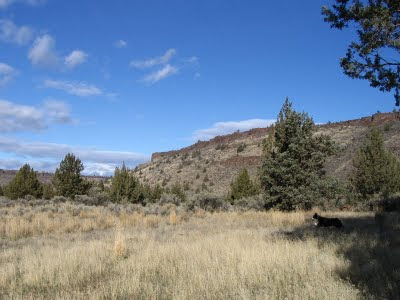Years ago, I came across a design book by architect Sarah Susanka called
The Not So Big House.
Susanka put into words what I had been thinking for years. She believes in designing homes “that favor the quality of its space over the quantity” not "the notion that houses should be designed to impress rather than nurture.”
I’ve always loved small spaces. The home we lived in for almost 18 years was a cottage built in 1925.

840 square feet on the main floor. I loved the intimacy it provided.
In the fall of 2006 we decided to move to the Central Oregon. We knew we wanted another house with a small footprint. We looked at house after house for almost 10 months. Half-way through the process, we realized moving to (at the time) the most expensive part of Oregon, wanting acreage, a house, and no mortgage was going to be a problem. We had to compromise somewhere.
With much grinding of teeth, we began looking at mobile homes on acreage. My husband asked me, “Can interior decorators really live in mobile homes?”
Living in a trailer, with fake paneling, plastic cupboards, shag carpeting, vinyl flooring, aluminum siding and metal slider windows held absolutely no appeal to me.
But after watching our formerly quiet country road in Silverton, sprout 200+ McMansions over the last 10 years, we knew we wanted the peace and quiet acreage would provide.
We bought 5 acres with views of the Three Sisters in Central Oregon’s High Desert.

We have 300+ days of sunshine a year, along with so much privacy I’ve yet to meet any neighbors....and we have a double-wide trailer. Life's funny, isn’t it?
It was late June of 2007 before we finally purchased this...home. A trailer. There was no beauty here. None.
This project has been my biggest design challenge to date. We gutted the entire inside…salvaging and donating items to the Habitat for Humanity resale shop, recycling wood and scrap metal as we went along. We tore out the cardboard and plastic ceilings, rewired and re-plumbed where necessary. We hired a crew to sheetrock over the existing paneling and then we coated the walls and ceiling with both low VOC (Devine) and zero VOC (Yolo) paints. We ripped out the germ-riddled plush carpeting and laid Eco-Timber solid bamboo flooring (using a non-toxic glue) throughout the entire house. We tore out (and recycled) aluminum slider windows, replacing them with energy efficient ones. We repurposed antique furniture into a vanity sink cabinet and linen closets rather than buying new pieces. The kitchen cabinets were purchased from a company who offered a green line of cabinetry. Paperstone (countertops made using 100% recycled paper and a non-toxic resin) was installed in the kitchen. Ten of the light fixtures we installed were found at second hand stores or purchased off Craigslist. We salvaged, reused and repurposed many items making our remodel as green as we could afford, and as beautiful as possible....and we paid cash.
Before and after photos here 













 I'm taking a desert friend to my former hometown of Silverton for a tour of the Oregon Garden. We're going to stay overnight at the Oregon Garden Resort which offers a smokin' mid-week deal of guestroom with a private patio and fireplace, dinner at Oregon Garden Resort Restaurant plus one bottle of House wine, admission to The Oregon Garden and full American buffet breakfast...all for $89. Unbelievable.
I'm taking a desert friend to my former hometown of Silverton for a tour of the Oregon Garden. We're going to stay overnight at the Oregon Garden Resort which offers a smokin' mid-week deal of guestroom with a private patio and fireplace, dinner at Oregon Garden Resort Restaurant plus one bottle of House wine, admission to The Oregon Garden and full American buffet breakfast...all for $89. Unbelievable.
 Being the wife of an artist blacksmith, I found this creative reuse intriguing. But I have to wonder about the off-gassing of sun heated vinyl. Perhaps if it was placed outside, rather than inside...
Being the wife of an artist blacksmith, I found this creative reuse intriguing. But I have to wonder about the off-gassing of sun heated vinyl. Perhaps if it was placed outside, rather than inside...

